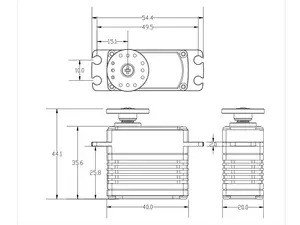

K-Power RC31P 32kg Wheel/servo Mode Metal Case Coreless Rc Servo For Rc Car Robot Arm Humanoid Robot DIY


RUSH TANK MAX SOLO 5.8GHz 2.5W High Power 48CH VTX Video Transmitter For RC FPV Long Range Fixed-wing Drones DIY






















Radio-controlled (RC) technology has come a long way since its inception in the late 1940s. From simple 'on-off' systems to the advanced technologies of today, the evolution of RC channel technology has been nothing short of fascinating. This article delves into the latest innovations in RC channel technology, exploring how advancements like 2.4 GHz radio systems, Frequency Hopping Spread Spectrum (FHSS), telemetry systems, and the integration of Artificial Intelligence (AI) are revolutionizing the hobby. We'll also discuss how these innovations enhance control, precision, range, and reliability, and provide real-time data and feedback, transforming the way we engage with our hobbies.
The evolution of RC channel technology has been a fascinating journey. Starting with simple 'on-off' systems in the late 1940s, the technology evolved to use complex relay systems for controlling speed and direction. The 1960s saw the advent of transistor-based equipment, leading to the development of fully proportional 'digital proportional' systems. The 1970s brought integrated circuits, making the electronics small, light, and cheap enough for wider availability. By the 1990s, miniaturized equipment became commonplace, even in inexpensive toys. Today, we see the use of advanced technologies like Pulse-Code Modulation and 2.4 gigahertz transmissions in high-end RC models.
The RC channel technology has seen significant advancements over the years. The introduction of 2.4 GHz radio systems revolutionized the RC world, eliminating the need for crystals and providing glitch-free signal transmission. This technology brought an end to frequency conflicts and made RC racing more efficient. The latest innovations include brushless motors and LiPo batteries, which offer more power, better efficiency, and simpler maintenance. These advancements have significantly improved the performance and reliability of RC vehicles.
Frequency-hopping spread spectrum (FHSS) is a method of transmitting radio signals by rapidly changing the carrier frequency among many frequencies. This technology is used to avoid interference and prevent eavesdropping. The frequency band is divided into smaller sub-bands, and signals rapidly change their carrier frequencies among these sub-bands in a determined order. FHSS offers four main advantages over a fixed-frequency transmission. It's used in many hobby transmitters and receivers for radio-controlled model cars, airplanes, and drones, allowing hundreds of transmitter/receiver pairs to operate simultaneously on the same band.
Telemetry systems have become a crucial part of RC technology, providing pilots with valuable real-time information. These systems allow you to monitor your model's battery voltage, motor rpm, and motor temperature. This is made possible through advanced transmitters that feature built-in telemetry data receivers, displaying this information on their LCD screens. These advancements in telemetry systems not only enhance the control and precision of RC models but also significantly improve their range and reliability.
Artificial Intelligence (AI) and machine learning are revolutionizing RC channel technology. These advanced technologies enable systems to learn from data, identify patterns, and adjust to new inputs, enhancing the performance of RC devices. AI can be applied to improve control precision, reduce human errors, and adapt to changing conditions. The integration of AI in RC technology offers the potential for autonomous operation, real-time data analysis, and improved reliability, transforming the way we engage with our hobbies.
The latest innovations in RC channel technology have revolutionized the hobby. These advancements have made the hobby more accessible, safer, and smarter. For instance, the new generation features of advanced LiPo batteries make them simpler and safer to use. They come programmed to discharge automatically to a safe storage voltage after 72 hours of inactivity, ensuring longer battery life and better performance. Additionally, advanced AC chargers bring user-friendly charging technology, making battery charging easier than ever.
RC systems have from 2 to 10+ channels, allowing for precise control of multiple servos. The RC transmitter outputs the signal while the receiver receives it, enabling wireless communication to your servo. Servos, which are DC motors with built-in gearing and feedback control loop circuitry, offer precision positioning, making them ideal for robot arms and legs, rack and pinion steering, and sensor scanners. They are fully self-contained, making the velocity and angle control loops easy to implement. The signal wire is used to command the servo, with the wavelength directly mapping to servo angle.
The discussion in the original content revolves around the range and reliability of different RC systems. Users share their experiences with various models, some of which have been reported to have range issues. Alternatives are suggested, which are praised for their reliable range. These real-world experiences underscore the importance of range and reliability in RC channel technology, and how advancements in these areas can significantly enhance the user experience.
RC telemetry systems have revolutionized the way we interact with our RC devices. This technology allows us to monitor real-time data such as speed, altitude, GPS coordinates, battery voltage, motor current, propeller RPM's, and fuel tank levels. With the right equipment, this information can be downloaded to flight data recorders, mobile phones, or even directly to our laptops. This real-time feedback enhances control, improves safety, and adds a new dimension to the hobby. Whether you're flying an RC plane or operating an RC car, telemetry systems provide valuable insights that can help optimize performance and prevent potential issues.
The future of RC toys sees the integration of mobile technology. For instance, accelerometer technology allows RC toys to be controlled using a mobile device. These toys have built-in IR sensors sensitive to hand motions, and can be controlled by simply tilting your mobile device. This innovation provides an easy way to navigate and overcome obstacles, demonstrating how users can adapt to new RC channel technologies.
Choosing the right technology for your needs is crucial in the world of RC channels. A recent innovation has revolutionized the industry. This clip, is designed to work with any type of RC channel, with no noticeable difference in sound performance. This means you can opt for a generic brand RC channel, saving significant costs without compromising on performance. When seeking the best sound performance at the most economical price, this clip is a worthy consideration.
Once your RC channel system arrives, our quick installation guides provide you with basic information for correct setup. If you still need additional help, our 24/7 technical service support experts are only a phone call away. We’ll walk you through every step from installation and testing, to calibrating and general operation questions to ensure your RC system is working correctly. We are committed to achieving the highest level of customer satisfaction, continually improving our products and internal processes.
The world of RC channel technology is constantly evolving, with innovations making the hobby more accessible, safer, and smarter. From the integration of AI and telemetry systems to the advent of advanced frequency hopping and the use of mobile technology, these advancements are revolutionizing the way we interact with our RC devices. Choosing the right technology for your needs is crucial, and with resources like quick installation guides and technical service support, mastering these new systems is easier than ever. As we look to the future, the integration of these advanced technologies promises to continue transforming our hobbies, offering an even more immersive and engaging experience.